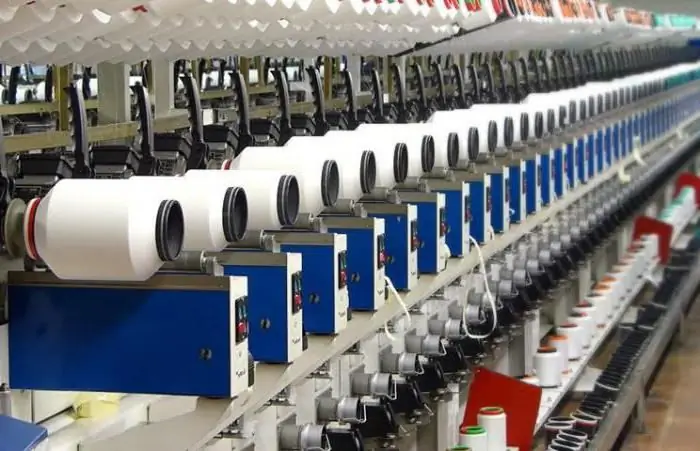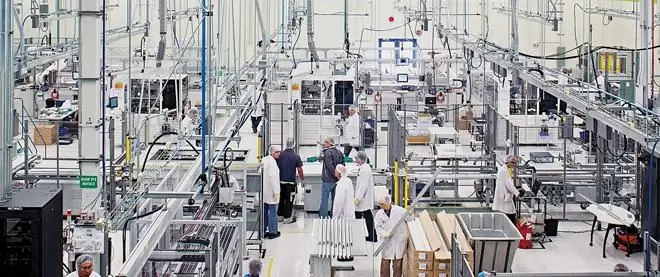2026 Author: Howard Calhoun | [email protected]. Last modified: 2025-01-24 13:10:43
One of the fundamental factors for the success of the Canadian economy is a developed industry. It is significantly integrated with the largest American enterprises, characterized by the presence of large amounts of foreign capital. Canada and its economy are integrating into the trends of globalization, the development of the information technology market, relationships in the areas of retail and investment. An important role in these processes, despite the adherence to capitalist principles, is played by the government of the country.
Geography factor
The main features of the location of Canada's industry are related to its geography. This country is northern, large in area, sparsely populated, and its main economic centers are located in the southern, eastern and western parts. They are separated by distances of thousands of kilometers.

About 85% of the employed population work in these areas of the country. At the same time, raw materials for the Canadian industry, as a rule, are mined in the North. Agricultural resources, logically, are concentrated in the South. As such, production is concentrated mainly in Ontario (there is also part of the farmland),Province of Quebec, Vancouver. Canada's industry is very dependent on export markets, mainly the US.
Country of Natural Resources
The Canadian economy is represented by many industries. In addition to the developed production, the country is the world's largest exporter of wood, one of the leaders in the export of fuel of mineral origin. Fresh water and forests are considered by many experts to be inexhaustible.

The oil and gas industry of Canada is especially developed - the country occupies the 3rd position, behind the USA and Russia, in gas production, the 6th - in the world ranking of countries for the production of "black gold". Diamonds are mined in the northwest of the country, 90% of which is sold to Europe. Canadians successfully produce uranium (about 18% of world production). Deposits of metals (iron, nickel, copper, rare earth elements), which are also in demand by European industries, are being actively developed.
Diversification Benchmark
Industry specialization of Canada's industry is represented by many segments - the production of automobiles, aircraft, metalworking, wood processing, paper production, chemical products. Developed food sector. Of course, Canada is also strong in high technology. With regard to innovation, business is supported by the government of the country.

It is worth noting that despite the noted development of various segments, Canada's industry is characterized by respect for the environment. It is clear that greenhouse gas emissions are high, but the country that withdrew from the Kyoto Protocol in 2011 set itself the task of reducing the amount of CO2 in the atmosphere by 17% by 2020 compared to 2005.
Military Rails
It is worth mentioning that Canada produces many types of military products. The state is a traditional ally of the United States (because it neighbors with them) and Great Britain (included with this country in the Commonwe alth of Nations and, concurrently, in NATO). The Canadian Army is equipped with advanced military equipment, including national production. About 90 enterprises work in the military-industrial complex of the country.

In addition to supplies for their armed forces, Canadians export military equipment to the United States and play an important role for the American army. For example, it is the "northern neighbor" of the United States that equips the latest technologies for detecting maritime targets, radar control panels for systems designed for early detection. It is worth noting that many of the Canadian military firms are wholly owned by the Americans.
Space and aviation
Industry Canada also produces aerospace equipment. This industry is represented by a group of hundreds of companies, and they employ about 40 thousand employees. These firms annually produce equipment worth more than 3 billion Canadian dollars, and it is exported to the USA, France, Germany and the UK. Among the main goods are parts, assemblies, equipment, that is, to a lesser extent, finishedproducts in the form of aircraft.

Although Canada has its own aircraft industry, including the production of aircraft engines. The share of military products is quite high: among them are CL-227, CL-89 drones, parts and assemblies for F-15 and F-18, F-111 bombers. Air-to-air, air-to-ground sounding rockets, various elements of jet engines and the power units themselves are produced.
Canadian shipyards
Canada is a supplier of modern ships, including military ships with a displacement of up to 5,000 tons. The shipyards of this large country produce ships for scientific needs (oceanographic, hydrographic), security services (patrol on boats), industry (dry cargo ships, tankers with a capacity of up to 150 thousand tons). The location of Canada's industry in the shipbuilding sector is spread across several major cities. Among them are Toronto, Montreal, Vancouver, Victoria, Halifax, St. Catharines, Sorel, St. John. Canada has a government program to modernize the fleet and build new warships. Demand for ships produced in this country (including from the armies of various states) remains high.
Unresolved Issues
Canada's manufacturing industry is a key factor in the competitiveness of the country's economy. At the same time, the country is experiencing difficulties in this direction of development: in order for the industry to produce high-quality products, stable investments in technology and equipment are needed. There have been periods in Canadian history whensuch investments were in short supply, in large part because of mounting debts in the foreign arena and subsequent problems with the state budget. The country has unemployment characteristic of capitalist economies, the duration of which tends to grow. As a result, investments in the industry are not very active, as a result of which the production base does not always meet the current demands of the world market.
Socialism in capitalism
Despite the fact that the Canadian economy is very dependent on the United States, it is characterized by increased state intervention (which is not very typical for developed countries). The government cares, first of all, about the social well-being of citizens. And because the administrative factor affects almost all industries in Canada. Some scientists call the economy of this state a "hybrid" between a liberal-oriented type and a social one.

At the same time, experts note that such a policy is not very effective. The state is sometimes forced to experience pressure from business. There were facts of "socialist" generosity, when investments were received by projects that did not have real commercial prospects. At the same time, the positive side of the increased influence of the state for the Canadian economy is called the standardization of some industries and, as a result, improving the quality of products.
Raw materials for the benefit of the economy
The country is rich in minerals and occupies a leading world position in the export of various metals andminerals. Canada has the largest deposits of uranium and coal. There are significant water resources, which allows the country to fully supply itself with electricity from hydroelectric power plants (part of the energy is successfully exported).

Developed, thanks to the natural resource base, the mining industry in Canada. Engineers and researchers from this country are constantly improving the technological infrastructure associated with this and other industry segments. The state helps with high-quality investments, laying the necessary amounts of financing in the budget. The resource orientation of the economy also determines the main features of the location of industry in Canada.
Banks decide a lot
The law defines three main forms of credit institutions in Canada: "charter", trust banks and credit unions. In the region's economy, the role of the Toronto Stock Exchange, as well as a number of other trading floors, is noticeable. Their work is clearly regulated by local administrations in the provinces (but there is also a federal structure - the Oversight Service, which specializes in managing the noted financial structure in Toronto). The movement of capital from the country and back has no legal restrictions. The national currency of the state is the Canadian dollar, which, by analogy with the American "brother" of 100 cents. It is worth noting that the Central Bank of Canada reports directly to the Parliament of the country (in many other capitalist states, institutions with a similar status are often independent of the state).
Recommended:
Clothing industry as a branch of light industry. Technologies, equipment and raw materials for the clothing industry

The article is devoted to the clothing industry. The technologies used in this industry, equipment, raw materials, etc. are considered
Dairy industry in Russia. Dairy industry enterprises: development and problems. Dairy and meat industry

In the economy of any state, the role of the food industry is huge. Currently, there are about 25 thousand enterprises in this industry in our country. The share of the food industry in the volume of Russian production is more than 10%. The dairy industry is one of its branches
SC "Capital" in Zelenograd: shops, location and features

This article describes the network of shopping malls "Capital", which are located in Zelenograd. Here you can learn about the features of the shopping center, as well as their location and addresses
SHangal shopping center in Novogireevo: assortment, features and location

This article provides an overview of the shopping center "Shangal", located in the Moscow district of Novogireevo. The assortment, location and features of the complex are described
LCD "21st century", Kazan: features and location

"Kazan 21st century" is a project that meets the modern idea of comfortable housing. Within the framework of this material, we will try to give him the most objective assessment

